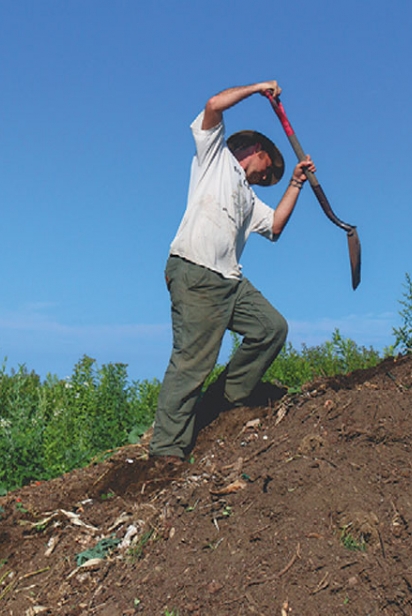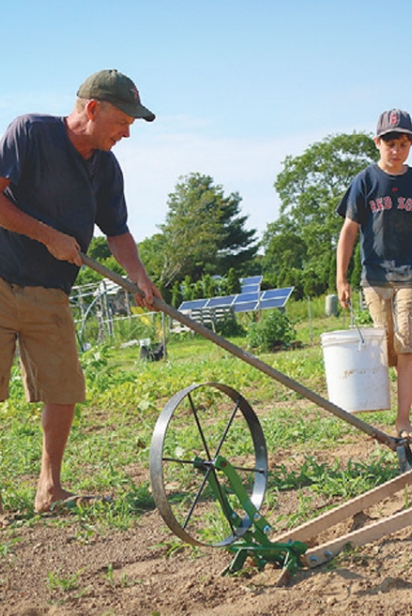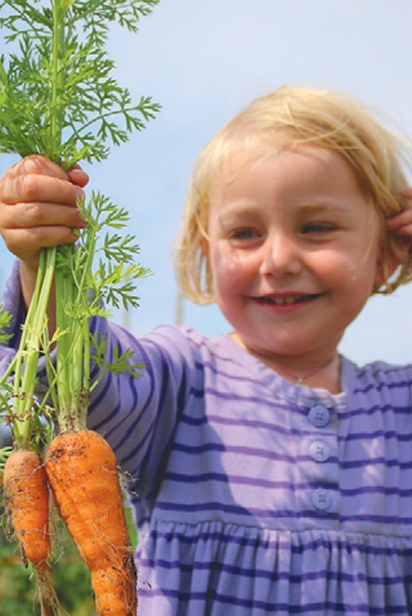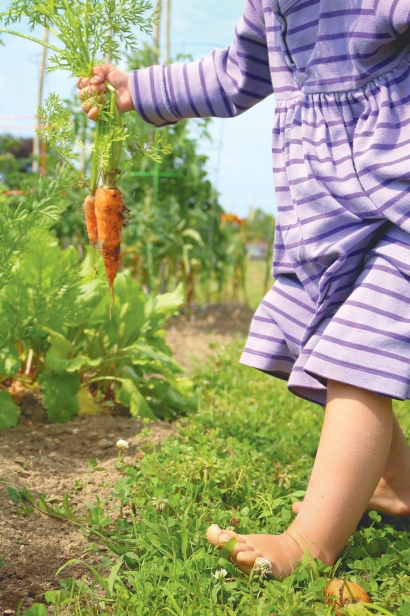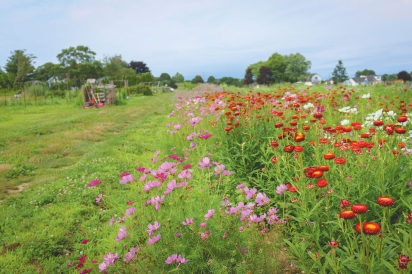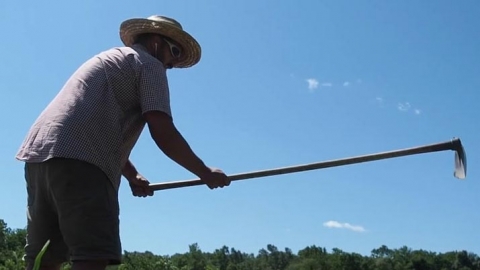Island Community Farms
Growing Gardeners and Farmers on Aquidneck Island
Nestled amongst the cookie-cutter homes and manicured lawns of suburban Middletown lies a plot of land unlike any other on Aquidneck Island. For decades a field growing potatoes for Frito-Lay, today it is a place for islanders of all ages and abilities to grow their own food and participate in sustainable farming practices.
Home to 33 community garden plots, three micro-farms, a permaculture food forest, a food scrap collection and composting operation, children’s garden and shared community event space, Island Community Farms is filling the shelves, bellies and hearts of Aquidneck islanders.
Owned by the Aquidneck Land Trust, the land is leased by the nonprofit group Aquidneck Community Table (formerly known as Sustainable Aquidneck). The eight and a half acres on Elizabeth Lane is now equal parts outdoor classroom, experimental initiative and small business incubator.
“It was a perfect property for us to do a community farm on,” says Aquidneck Land Trust Executive Director Chuck Allot, adding how the Land Trust typically purchases conservation easements— not land titles—except in special cases like this. “I think that very quickly everyone realized that there was a real synergy. We’re focused on doing more community conservation surrounding food equity, local food production and drinking water protection—because there’s so much more that the land can—and needs to—do for us."
As most great ideas do, it all started over dinner. Joining forces over a shared passion for local food and the sudden availability of a gorgeous parcel overlooking the Sakonnet River, Aquidneck Community Table (ACT) took root with Island Community Farm as its pilot project.
“Our intent was to demonstrate sustainability, rather than simply start a farm,” says Bob Gerber, who serves on the board of ACT. “So our whole idea was to do many things."
Converting the land from mono-crop to multi-use was a physical and fiscal undertaking. For $15,000 (about what it would have cost to connect the farm to the grid and pay for electricity) the group installed a solar-powered well pump—allowing the crops to be both grown and watered by the sun. Volunteers mowed and turned the field with a grant- and community-funded tractor, and divided it into separate growing areas. Meanwhile, they’d implemented a food scrap collection service at the Aquidneck Growers’ Market, raising mountains of compost for the gardeners and farmers to use. Finally, they planted seeds.
Grow
The joint is jumpin’ on a balmy summer Saturday. Gardeners, farmers, friends and family are hard at work gathering the bounty of the season and preparing for a late-afternoon potluck.
Over to the south side of the field, Jim Garman and his family are busy harvesting greens—mammoth Russian red kale. The largest of Island Community Farms’ micro-farms, the Garmans run a 65-family CSA and farm-to-restaurant business on 2.8 acres.
“When I was 18, the thought that you could make a living off of three or four acres would have been unheard of,” says Garman, 44, who sells to two island grocers (A Market and The Green Grocer) and numerous restaurants. “The boutique farm didn’t exist."
Garman always wanted to be a farmer but couldn’t imagine making a living farming—so he became a professor of historic preservation and agriculture at Salve Regina instead. When he saw a Craigslist ad— “a life changing thing” —posted by ACT executive board members Jason and Meredith Spitalnik four years ago, he jumped at the chance to fulfill a lifelong dream.
He says the change has been a full-family endeavor, with his wife, Michelle, and children Michael, 12, and Sophie, 10, committing their effort as well. With a wry look at her step-kids, Michelle says, “It’s an entire lifestyle change. When we started this Michael was 7, and he hated it. We would come out here and he’d be like, ‘You find this enjoyable? You find this relaxing?’ And now we’ll say, ‘We need 4,000 snow pea pods—go to town!’”
When I ask Michael what changed, he explains how he “adjusted to it and realized there’s more to it than it seems.” He shares his favorite Facebook meme, which reads, “Hooray, It’s Friday! Oh wait … I’m a farmer."
Teach
Bouncing her then-1- year-old son on her knee after a walk in the food forest, Meredith Spitalnik explains how she and Jason arranged the farm for maximum family participation even before they had children of their own.
“We definitely designed the space with families in mind,” she says. “That’s why the community gardens are right here next to the children’s garden, so that when the parents are working they have a place to let their kids roam, be independent and safe. That’s what we’re going for."
Hera Tar and her 4-year-old daughter Madelyn are two community gardeners taking advantage of the Spitalniks’ design. New to gardening, Tar says it was always something she wanted to do and finally got started when she became pregnant with Madelyn.
“It’s super important to me for my daughter to be involved—to learn where food comes from, to witness the magic of the earth and watching the plants grow, and how everything works together—the air, the sunlight, the earth, the water—all of the elements coming together, and how everything goes in a circle,” Tar explains.
This summer, Tar and Island Community Farm Operations Director Horus Khuit are creating a number of interactive spaces for kids and families. The children’s garden is a path-lined patch of berries, carrots, asparagus, cherry tomatoes and edible flowers for little ones to pick and eat on the spot. The “three sisters” bed is a lesson in ancient Native American growing practices, and the mandala garden with its pie-slice beds of vegetables extending out from a center of trellised vines and sunflowers demonstrates how growing food can be an artistic expression as well as a practical endeavor.
Khuit explains his motivation behind all these projects is to entice more people to grow their own food.
“Here, everybody’s learning and building their skills, which is so important because we’re in a failing system right now,” he says. “We’ve been learning from the past in the ways that we interact with society and community, and now we have the ability to build on all of it and pull together a better, sustainable [food] system. So this farm is a step towards that."
Share
For the casual or beginning gardener, Island Community Farm is a place to learn from others. With so many people with differing experience levels growing on the same piece of land, knowledge is shared as freely as the sun and water.
“I really like growing around other people,” says Cindy Shea, who runs the micro-farm Wicked Greens. “It’s such a cross-pollination— when I have a problem I’ll go to Jim or Michelle because they’ve been doing this for quite a few more years. But I also learn from the community gardeners or they’ll have questions for me."
Jim Garman is in agreement, adding that for a small farmer working long hours, “It’s really nice having people to talk to other than ourselves."
For those beginning gardeners worried about starting from scratch, Bob Gerber offers some advice: “As long as you’re willing to put in the minimum amount of effort, it’s always worthwhile,” he says. “You will succeed. You may succeed at learning what to do better next year, but you’ll still eat some vegetables the first season. And you’ll feel great.”
For more information about Aquidneck Community Table and its programs, including Aquidneck Growers’ Market; Island Community Farms and Composting Program; and Island Community Gardens, visit AquidneckCommunityTable.com.




